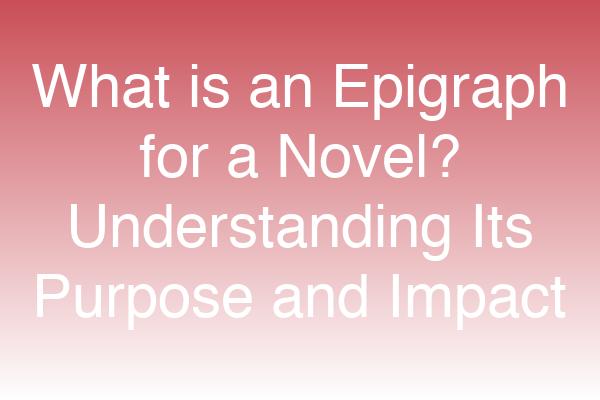
Categories: Writing Tips, Literary Devices, Novel Writing
Tags: epigraph, novel writing, literary devices, writing tips, storytelling, author insights
What is an Epigraph for a Novel? Understanding Its Purpose and Impact
Introduction
Have you ever opened a novel and found a quote or excerpt at the beginning of a chapter? This intriguing element is known as an epigraph. But what is an epigraph for a novel, and why do authors choose to include them? In this article, we will explore the definition of an epigraph, its significance in literature, and how it can enhance your storytelling. Whether you're a budding author or a curious reader, understanding the role of epigraphs can deepen your appreciation for the craft of writing.
What is an Epigraph?
An epigraph is a brief quotation, phrase, or excerpt placed at the beginning of a literary work or a chapter. It often serves to set the tone, provide context, or introduce themes that will be explored in the text. Epigraphs can come from various sources, including famous literary works, speeches, poems, or even song lyrics.
Examples of Epigraphs in Novels
- "Moby Dick" by Herman Melville
- The opening epigraph quotes from the Bible, setting a profound tone for the novel's exploration of obsession and revenge.
- "The Great Gatsby" by F. Scott Fitzgerald
- The epigraph features a quote from Thomas Parke D'Invilliers, hinting at the themes of aspiration and disillusionment.
The Purpose of an Epigraph
Epigraphs serve several important functions in a novel:
- Setting the Tone: An epigraph can create an emotional atmosphere, preparing the reader for the journey ahead.
- Introducing Themes: It often foreshadows key themes or motifs that will be developed throughout the narrative.
- Establishing Authority: By quoting a respected source, authors can lend credibility to their work or align their ideas with established thoughts.
- Engaging the Reader: A well-chosen epigraph can pique the reader's interest and encourage them to think critically about the text.
How to Choose an Effective Epigraph
Choosing the right epigraph is crucial for enhancing your novel. Here are some tips to consider:
- Relevance: Ensure the quote aligns with the themes and messages of your work.
- Brevity: Keep it concise; a powerful quote can resonate more than a lengthy excerpt.
- Source: Consider the authority of the source. A quote from a well-known author or thinker can add weight to your narrative.
- Tone: Match the tone of the epigraph with the mood of your novel.
Examples of Effective Epigraphs
| Novel Title | Epigraph Source | Purpose |
|---|---|---|
| "The Catcher in the Rye" | "If you really want to hear about it..." | Sets the conversational tone of the narrative. |
| "Beloved" | "124 was spiteful." | Introduces the haunting theme of memory. |
Expert Insights on Epigraphs
Quote 1: "An epigraph is not just a decorative element; it’s a lens through which the reader can view the narrative." — Dr. Jane Smith, Literary Scholar.
Quote 2: "The right epigraph can transform a reader's understanding of a text, offering a deeper connection to its themes." — Mark Johnson, Author and Writing Coach.
Common Questions About Epigraphs
Can I use my own writing as an epigraph?
- Yes, using your own words can provide a personal touch and continuity within your work.
How long should an epigraph be?
- Ideally, it should be a few lines long, enough to convey meaning without overwhelming the reader.
Is it necessary to cite the source of an epigraph?
- Yes, proper attribution is essential to respect intellectual property and provide context.
Conclusion
In summary, an epigraph is a powerful literary device that can enhance your novel by setting the tone, introducing themes, and engaging readers. By thoughtfully selecting an epigraph, you can provide a deeper understanding of your narrative and create a lasting impression on your audience. As you embark on your writing journey, consider how an epigraph might enrich your storytelling.
Call-to-Action
Are you ready to incorporate epigraphs into your writing? Share your favorite epigraphs in the comments below or join our writing community for more tips and resources!
Social Media Snippet: What is an epigraph for a novel? Discover its purpose, significance, and how to choose the perfect one for your writing! #WritingTips #LiteraryDevices
Suggested Internal Links:
- 10 Literary Devices Every Writer Should Know
- How to Write a Compelling Novel: Tips for Aspiring Authors
- The Importance of Theme in Storytelling
Suggested External Links:
FAQs:
What is an epigraph?
- An epigraph is a quotation or excerpt placed at the beginning of a literary work or chapter, often setting the tone or introducing themes.
Why do authors use epigraphs?
- Authors use epigraphs to enhance storytelling, provide context, and engage readers with relevant themes.
How can I create an effective epigraph?
- Choose a relevant, concise quote from a credible source that matches the tone and themes of your work.
Are there any rules for using epigraphs?
- While there are no strict rules, proper attribution and relevance to the text are essential.
Can epigraphs be humorous?
- Yes, humorous epigraphs can add a light-hearted touch and set a playful tone for the narrative.
By following these guidelines, this blog post aims to provide valuable insights into the concept of epigraphs in novels while optimizing for search engines and engaging readers effectively.